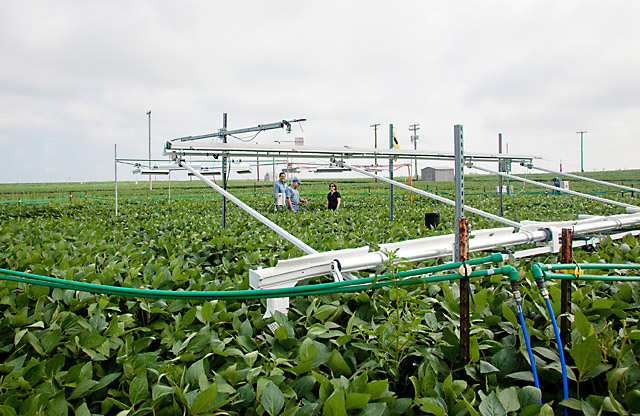Some Crops Tolerate Ozone Pollution Better Than Others, Study Finds
Contact: Jan Suszkiw
Email: Jan.Suszkiw@usda.gov
December 5, 2023
Differences in the photosynthetic "machinery" of certain crop plants can make them more or less prone to harm caused by ground-level ozone pollution, according to a recent Proceedings of the National Academy of Sciences paper published by a team of Agricultural Research Service (ARS) and University of Illinois scientists in Urbana-Champaign (UIUC).
The findings—that so-called "C4" crops like corn and sorghum tolerate increased ozone levels better than "C3" crops, like rice or snap beans—open the door to better models for predicting crop responses to the effects of global climate change, as well as developing more resilient varieties that can sustain humanity’s increasing demand for food, feed, fiber and fuel.
A crop is designated as C3 or C4 depending on whether the CO2 it captures from the air is initially converted into a 3-carbon or 4-carbon compound. The general ability of C4 crops to tolerate increases in ground-level (or “tropospheric”) ozone better than C3 crops has long been suspected but not widely tested under actual field conditions, noted Lisa Ainsworth, a research molecular biologist who leads the ARS’s Global Change and Photosynthesis Research Unit at UIUC.
Together with her PNAS co-authors—namely, ARS research plant physiologist Christopher Montes and a UIUC team led by Shuai Li—Ainsworth conducted an extensive analysis of both published and unpublished data—the first set culled from 46 journal papers and the second set from 20 years’ worth of open-air experiments conducted in the United States, India and China.
Specifically, their analysis focused on the responses of five C3 crops (chickpea, rice, snap bean, soybean and wheat) and four C4 crops (sorghum, corn, giant miscanthus and switchgrass) to both ambient levels of ozone and increased concentrations of the gas, ranging from 40 to 100 parts per billion. Of particular interest were changes in the crops’ photosynthetic capacity, chlorophyll content and fluorescence (a form of measurement for the pigment), antioxidant leaf activity, biomass material and seed yield. Drilling down a bit further, the team also compared the ozone sensitivities of hybrid and inbred lines of corn and rice.
C3 and C4 crops differ in how their leaves capture carbon dioxide from the air as a key component of photosynthesis. It is the process by which plants use sunlight to convert carbon dioxide into glucose, a sugar that helps power their growth, repair and development—and, in turn, sustain other forms of life on the planet, including humankind.
While both C3 and C4 crops use the enzyme called rubisco to convert carbon dioxide into sugars, C4 crops isolate rubisco in specialized cells where the concentration of carbon dioxide is very high. This enables higher rates of photosynthesis and greater efficiency of water use. Thus, C4 plants have lower stomatal conductance, resulting in less diffusion of carbon dioxide and ozone into leaves.
 Open-air field experiments are clarifying how some crops respond to ground-level ozone pollution. (Photo by Peggy Greb, D1546-2)
Open-air field experiments are clarifying how some crops respond to ground-level ozone pollution. (Photo by Peggy Greb, D1546-2)
According to Ainsworth, the open-air experiments—properly known as "Free-Air Concentration Enrichment (or "FACE")—provide a kind of ground truth about crop sensitivity to ozone (and carbon dioxide) that closed-air studies cannot.
"We’ve used both controlled environments and field studies to investigate crop responses to ozone," said Ainsworth. "The advantage of FACE experiments is the real-world setting for experimentation. Plants are grown in soil, not pots, and there is no disruption of the continuum from soil to plant to atmosphere."
In general, the team reported in their PNAS paper, exposure to increased ozone levels correlated with reduced chlorophyl content, fluorescence and seed yield in C3 crops more than the C4 group.
But there were differences within the two categories of crops as well, with snap bean, rice, wheat, chickpea, soybean, maize, giant miscanthus, sorghum and switchgrass being ranked the most to least ozone sensitive. These findings differ from prior results that suggested soybean was the most sensitive and rice the least. Another finding highlighted in the PNAS paper was that increased ozone inflicted lower grain yield losses in hybrid lines of corn and rice than inbred lines.
The researchers note that current studies would benefit from side-by-side comparisons of the crops under open-air conditions. The protective role of phenolics and other antioxidants in the leaves of C4 crops also warrants further study.
Ainsworth said ozone pollution has risen to the level of other environmental stressors such as pressure from pests and disease, as well as drought and diminished soil health. However, there is hope for better crop resiliency. For example, the genetic variability in them can be key to unlocking traits for greater tolerance or photosynthetic efficiency. Also, management decisions that farmers can make—such as growing crops in new areas, planting earlier in the season or using later-maturing varieties—could further improve crop tolerance.
The Agricultural Research Service is the U.S. Department of Agriculture's chief scientific in-house research agency. Daily, ARS focuses on solutions to agricultural problems affecting America. Each dollar invested in U.S. agricultural research results in $20 of economic impact.
